Stevens Brothers
(Wolverhampton) Limited
| The Stevens brothers must have been devastated after the
closure of A.J.S. in October 1931. They lost nearly
everything in the process, and yet decided to roll up their
sleeves and start all over again from the beginning. Luckily
they still owned their old Retreat Street premises, which in
the intervening years had been used by the Stevens Screw
Company Limited. Working on a shoestring they set up a new
company called Stevens Brothers (Wolverhampton) Limited, in
May 1932. The directors were the five Stevens brothers;
Harry, George, Joe, Jack and Billie. Working around the
clock, and assisted by a number of unpaid volunteers, they
managed to design and develop the 'Stevens Light Commercial
Vehicle', a three wheeled van.
| Read about the
Retreat Street factory |
 |
|
|
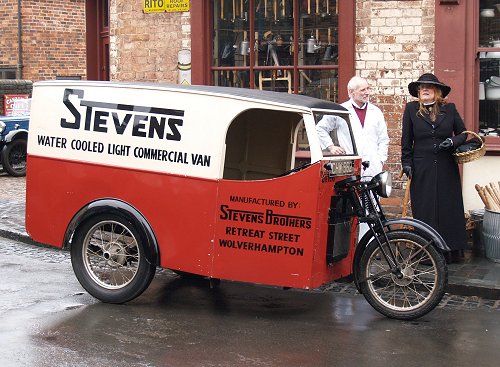
The Stevens 3-wheeled van that can be
seen at the Black Country Living Museum. |
It was based on a prototype three wheeled vehicle, built
in 1921 at the A.J.S. works on Graiseley Hill, that had two
wheels at the front and one at the rear.
The Stevens van used motorcycle technology, with a single
wheel at the front, carried on heavy duty motorcycle forks.
There was a steering wheel, connected to the front wheel
by two roller chains, and a water-cooled single-cylinder,
side valve, Stevens 588c.c. engine, with dry sump
lubrication.
The rear wheels were chain driven from a Burman 3 speed,
plus reverse, gearbox. |
| The van was fitted with a foot operated kickstart lever,
and a throttle, mounted in the centre of the steering wheel.
Initially a full-width bench seat was fitted but soon
replaced by a large motorcycle saddle. The bodies were
bought-in and had a capacity of 91cu.ft.
Initially no front doors were fitted, they became
standard at a later date. The vehicle weighed 7.75cwt. and
could carry 5cwt. It had a top speed of about 45m.p.h. and
sold for £83.
From late in 1932 the vans were also built in London by
Bowden (Engineers) Ltd., who had a manufacturing agreement
with Stevens.
The vans sold quite well, and a building across the road
in Retreat Street was rented from storage and furniture
removers, S. Lloyd & Sons, so that production could be
stepped-up.
The vans were assembled in batches of six. When one batch
was sold, work could begin on the next batch. |
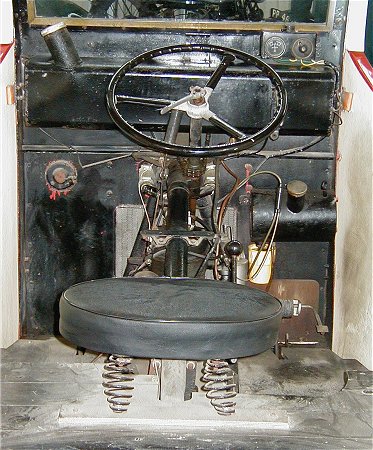
Looking through the back doors of the Stevens
van at the Black Country Living Museum. |
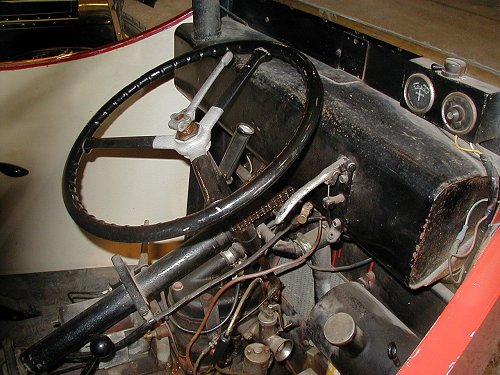
A close-up view of the steering
wheel and engine in the Stevens van at the Black Country Living Museum. |
An improved version was launched in
October 1935 with an improved chain drive. The earlier chain
had a habit of breaking, and so it was replaced by a drive
shaft, which required the repositioning of the gearbox.
The improved van could now carry 8cwt.
and sold for £93.9s.0d. and was also available as an open
truck.
 |
| Read
about the new version of the van |
|
|
Because the company ran on a
shoestring, the expensive up-to-date machinery that had been
in use at Graiseley Hill, was not affordable. As a result
everything had to be finished by hand.
The late Geoff Stevens, who worked at
the company during the early days, remembered making cams by
roughly cutting out a circle, then hand filing it to the
correct profile.
Production continued until late in
1936, by which time sales declined, because customers
preferred the comfort and convenience of a 4 wheeled van.
It is believed that around 500 Stevens
vans were built, of which only a few are known to have
survived. |

An advert from April 1933. |
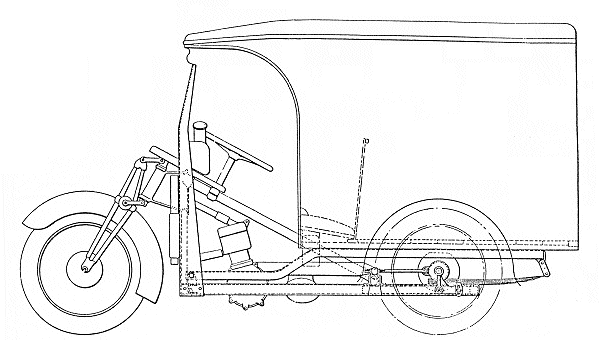
A drawing of the van. Courtesy of the late Geoff
Stevens.
 |
|
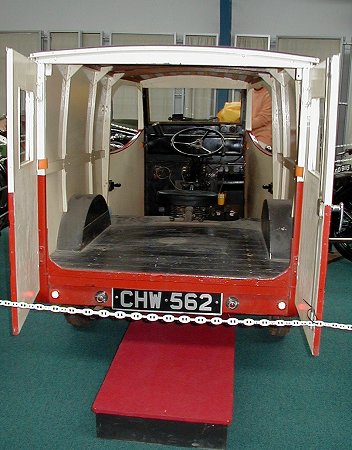 |
|
A front and rear
view of the Stevens van that's in the collection at the
Black Country Living Museum. |
| Stevens Brothers also produced a number
of engines for E. C. Humphries of the O.K. Supreme Company,
and A.J.W. using the 'Ajax' name.
It was clear that the
Stevens company could not support all five directors, and so
in 1934 Joe and Jack left to start their own company,
Wolverhampton Auto-Machinists Limited, which carried out
jig-boring, and produced jigs, and fixtures for the
engineering trade.
In between 1934 and 1938 Stevens Brothers produced around
1,000 Stevens motorcycles. When production ended the company
concentrated on general engineering work. |
|
A Stevens Brothers advert in the
November 1938 edition of Flight Magazine lists the following
trade services: light engineering work, machined parts,
assemblies, wire & tube manipulators, welding, light
presswork, etc.
By the late 1930s age was catching up
with the brother’s father, Joseph Stevens and so his
youngest son Billie took over the running of the Stevens
Screw Company, which by the early 1950s employed over 70
staff. Production consisted of hundreds of different small
parts including bolts, nuts and screws, in ferrous and
non-ferrous metals, made from the bar.
In 1938 Billie’s son Jim began to work
at Stevens Brothers after leaving school.
During the Second World War Stevens
Brothers manufactured and machined components for most of
the leading aircraft companies, including Bristol and Fairey
Aviation, Avro, Handley Page, etc., and were sole manufacturers
of the torpedo depth setting gear fitted to every Fairey Swordfish torpedo
bomber. At the time Stevens Brothers were much sought after
to take on jobs that other businesses could not, or would
not do.
After the war, the firm carried out light
engineering work, and also produced office equipment for Ellams Duplicators, under licence.
In the 1950s Jim Stevens took the
decision to sell Stevens Brothers (Wolverhampton) Limited.
By this time his father and uncles had died, and the sale
would allow him to concentrate on the running of the Stevens
Screw Company Limited.
Stevens Brothers was acquired by Leo
Davenport, a successful businessman, who had previously been
a successful competition rider for A.J.S., both at home and
abroad. His father Tom Davenport had also worked for A.J.S.
at Graiseley Hill, where he held a managerial post. |
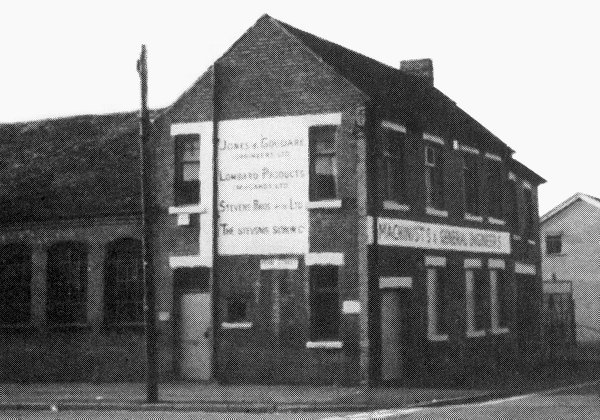
Retreat Street Works in the 1980s. Courtesy of the
late Geoff Stevens.
|
Stevens Brothers continued to be
successful under Leo. Everything in the works had to be just
right. In the machine shop stood a row of capstan lathes
which were always kept in immaculate condition. Leo also did
work for the Stevens Screw Company. Two other businesses
were run from the Retreat Street premises. The first, Jones
and Goodare was owned by the Stevens Screw Company, the
second, Lombard Products, Midlands Limited was owned by Leo
Davenport.
All of Stevens Brothers machinery was
driven from overhead line shafting, powered by an electric
motor that stood in the corner of the machine shop. Every Friday at 5 o’clock the machines were
shut off, and thoroughly cleaned. Cleaning time ended at
5.30 when the foreman, Bill Priest made an inspection.
Between 30 and 40 people worked in the machine shop. The
stores were run by Jack Bennett who also drove the company’s
van.
In 1992 it was all over, the end of
an era. The factory was acquired by Engines Limited,
and later W. Hopcraft & Son Limited, monumental masons.
Although the buildings still survive, they have been empty
for several years.
|
 |
Return to the list
of manufacturers |
|